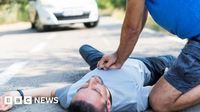Learner drivers across the United Kingdom are set for a significant change: from early 2026, those sitting their driving theory test will face new questions on cardiopulmonary resuscitation (CPR) and the use of automated external defibrillators (AEDs). The move, announced on August 13, 2025, by the Driver and Vehicle Standards Agency (DVSA), marks a major step in the UK’s ongoing efforts to boost cardiac arrest survival rates and equip more citizens with life-saving skills.
Currently, every learner must pass the theory test—scoring at least 43 out of 50 on a range of topics from road signs to first aid—before booking their practical driving exam. The test also includes a hazard perception video section. With over 2.4 million theory tests taken each year and a pass rate hovering around 45%, the new CPR and AED questions are poised to reach hundreds of thousands of new drivers annually, according to DVSA figures cited by Sky News and the BBC.
The urgency behind this educational update is stark. Data from Resuscitation Council UK, as reported by the BBC and Sky News, shows that more than 40,000 people in the UK suffer an out-of-hospital cardiac arrest each year. Tragically, fewer than one in ten survive. But research is clear: if CPR and a defibrillator are used within three to five minutes of collapse, survival rates can soar as high as 70%. Every minute without intervention reduces a person’s chance of survival by up to 10%.
For many, these statistics are more than just numbers. The campaign to add CPR and AED content to the driving theory test was led by Professor Len Nokes, chair of Save a Life Cymru, whose daughter Claire died in 2017 from complications following a cardiac arrest. Professor Nokes told Sky News, “When Claire, my daughter, had her cardiac arrest, some knowledge of CPR might have made a difference. I don’t want any other family to go through this experience. All of us in this partnership hope that by making CPR and how to use a defibrillator part of the theory test, we will be able to significantly increase the number of people who have this life-saving awareness.”
James Cant, chief executive of Resuscitation Council UK, echoed this sentiment in an interview with the BBC, stating, “By embedding these life-saving skills into such a widely taken assessment, we can help ensure that more people, from all communities, gain the knowledge and confidence to act during a cardiac arrest.”
The new questions will be added to the multiple-choice section of the car and motorcycle theory test, with plans to include them in other vehicle categories later. Official DVSA learning materials have already been updated to reflect this change. For example, learners will now be asked questions such as, “Who can use a public access defibrillator?”—the answer being “everyone.” The learning resources also cover practical aspects, like the correct chest compression depth for adult CPR (5 to 6 centimeters) and the recommended rate of compressions (100 to 120 per minute), as advised by the NHS and highlighted by the BBC.
Importantly, the DVSA has clarified that these updates will not make the theory test longer, more expensive, or more difficult overall. Instead, they simply modernize the first aid content to reflect current best practice, ensuring that new drivers are not only prepared to handle emergencies on the road, but also empowered to act confidently when witnessing a cardiac arrest—whether at a roadside, service station, or anywhere else.
Mark Winn, the DVSA’s chief driving examiner, emphasized the broader importance of these skills. “Part of being a safe and responsible driver is knowing what to do in an emergency—how to step in and make a real, life-saving difference,” he told Sky News. “Learning CPR and how to use a defibrillator is a very simple skill and adding this into the official learning resource is a great way for DVSA to support the drive to raise awareness.”
The collaboration behind this initiative is broad, involving the DVSA, Save a Life programmes in Wales, Scotland, and Northern Ireland, as well as Resuscitation Council UK. Together, these organizations aim to address the UK’s persistently low cardiac arrest survival rates, which have remained under 10% despite advances in emergency medicine. According to Sky News, the government also sees this move as part of its Plan for Change commitment to reduce preventable deaths and ease pressure on the NHS. Immediate bystander intervention can prevent organ failure and brain damage, potentially reducing the need for long-term rehabilitation and social care.
Drivers are often first on the scene when a cardiac arrest occurs—be it as a result of a road traffic collision, a medical emergency at a bus stop, or an incident at a motorway service area. The hope is that with millions more people trained in CPR and AED use, the odds of survival for cardiac arrest victims will improve dramatically. Currently, public-access defibrillators are used in fewer than 10% of cardiac arrests, in part due to a lack of public awareness and confidence. The new test content aims to change that, giving new drivers the skills and courage to act quickly and decisively.
The enhanced first aid questions will build on existing content that has been a part of driver education for years, but will now reflect the latest guidance and technology. Learner drivers will study CPR techniques, including proper hand placement and compression rates, as well as how to locate and use an AED. Free training resources, including step-by-step guides and videos produced by Resuscitation Council UK, are available to help candidates prepare.
While the change has been widely welcomed by health advocates and road safety experts, some have raised concerns about the already challenging pass rates for the driving theory test, which stood at 45.7% between July and September 2024. However, the DVSA has reassured the public that the additional questions are designed to be accessible and straightforward, focusing on practical knowledge that could save lives rather than adding unnecessary complexity.
Ultimately, the introduction of CPR and AED questions to the UK driving theory test represents a practical, compassionate response to a pressing public health issue. By equipping millions of new drivers with essential emergency skills, the initiative offers the promise of safer roads and, just maybe, a few more second chances for those whose hearts suddenly stop. For Professor Nokes and countless others touched by cardiac arrest, that hope is both deeply personal and profoundly important.






